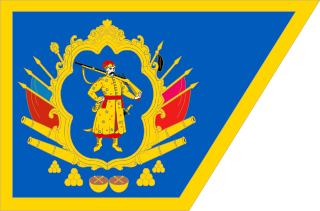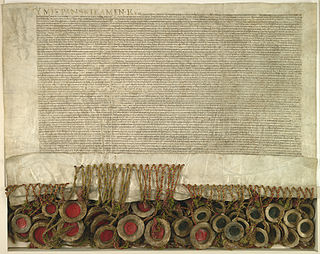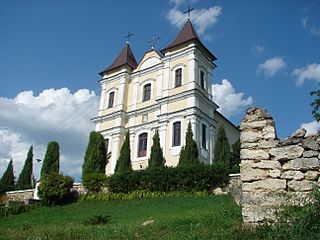This article needs additional citations for verification .(July 2021) |
Folwark [lower-alpha 1] is a Polish word for a primarily serfdom-based farm and agricultural enterprise (a type of latifundium ), often very large.
This article needs additional citations for verification .(July 2021) |
Folwark [lower-alpha 1] is a Polish word for a primarily serfdom-based farm and agricultural enterprise (a type of latifundium ), often very large.
Folwarks (Polish : folwarki) were operated in the Crown of Poland from the 14th century, in the Grand Duchy of Lithuania from the 15th century and in the joint Polish–Lithuanian Commonwealth from the second half of the 16th century. Folwarks also developed in the Commonwealth-controlled Ukrainian lands. The institution survived after the 18th-century Partitions of Poland until the early-20th century.
Folwarks aimed to produce surplus produce for export. The first folwarks were created on Church- and monastery-owned lands. Later, the folwark system was adopted both by the nobility ( szlachta ) and by rich peasants (singular: sołtys), but the sołtys positions were eventually taken over by the szlachta. [1]

The term folwark came into the Polish language in the 14th century from the German Vorwerk, originally the fortified advanced work of a castle and later an outlying manor house that managed a farm estate. The English translation would be "grange", the historical meaning of which is "an outlying farm with tithe barns belonging to a monastery or feudal lord". [2]
The development of folwarks was boosted by growing demand for grain and by the profitability of its export, both to Western Europe and within the Polish–Lithuanian Commonwealth. That led to the exploitation of serfdom since landowners discovered that instead of collecting money-based rent and taxes, it was more profitable to force the peasantry to work on folwarks. Folwark-based grain export became an important part of the economy of the Polish–Lithuanian Commonwealth.[ citation needed ]
Folwarks were primarily an early modern postfeudal rural formation. They originated as land belonging to a feudal lord (early on a knight) and were not rented out to peasants but worked by the owner's own hired labor or servants. The peasants toiled on the lots that they rented from the lord and were obliged to provide complimentary labour for the lord on his folwark, originally a few days per year. From the 16th century, the amount of this mandatory free labor was radically increased, and szlachta-sponsored legislation imposed rigid conditions on the peasants, such as the prohibition on worker's right to leave a village and seek a new lord. The originally-free peasants became serfs and then fell into a condition of extreme dependency and exploitation, known in Poland as wtórne poddaństwo [secondary serfdom]. Their lords, in turn, had become dependent on such free labour, which kept the folwark economy going and competitive on the European grain markets. [1] [3]
In Poland, serfdom was regulated and increased by the Statutes of Piotrków (1496) and by the Privilege of Toruń (1520), statutory privileges granted by kings to szlachta. With the fall of prices of agricultural goods at the end of the 17th century, the folwark economy went into crisis, and attempts by the szlachta to increase production by increasing the size of their folwarks (usually by appropriating peasant lands) and by demanding more labour (usually by increasing the peasant workload) only compounded the economic crisis and further worsened the fate of the peasants, who had been no poorer than their average counterparts in Western Europe.
In Lithuania, serfdom was fully established during the Volok Reform in the mid-16th century.
Until the late 18th century folwarks remained the basis of szlachta economic and political power. After the abolition of serfdom in Poland from the late 18th century onwards, folwarks used paid labour.
Folwarks were abolished by the People's Republic of Poland with the Polish Committee of National Liberation decree of 6 September 1944, concerned with agricultural reform. After the end of the Second World War, folwarks were nationalised at the behest of the Polish Workers' Party, resulting in PGRs, state-owned collective rural enterprises ( Państwowe Gospodarstwo Rolne , 1949 onwards) or partitioned, usually with little or no compensation to their owners.

The szlachta were the noble estate of the realm in the Kingdom of Poland, the Grand Duchy of Lithuania, and the Polish–Lithuanian Commonwealth who, as a class, had the dominating position in the state, exercising extensive political rights and power. Szlachta as a class differed significantly from the feudal nobility of Western Europe. The estate was officially abolished in 1921 by the March Constitution.

Serfdom was the status of many peasants under feudalism, specifically relating to manorialism, and similar systems. It was a condition of debt bondage and indentured servitude with similarities to and differences from slavery. It developed during the Late Antiquity and Early Middle Ages in Europe and lasted in some countries until the mid-19th century.

The Polish–Lithuanian Commonwealth, formally known as the Kingdom of Poland and the Grand Duchy of Lithuania, or simply Poland–Lithuania, was a bi-confederal state, sometimes called a federation, of Poland and Lithuania ruled by a common monarch in real union, who was both King of Poland and Grand Duke of Lithuania. It was one of the largest and most populous countries of 16th- to 17th-century Europe. At its largest territorial extent, in the early 17th century, the Commonwealth covered almost 1,000,000 km2 (400,000 sq mi) and as of 1618 sustained a multi-ethnic population of almost 12 million. Polish and Latin were the two co-official languages, and Roman Catholicism served as state religion.

The Lithuanian nobility or Lithuanian szlachta was historically a legally privileged hereditary elite class in the Kingdom of Lithuania and Grand Duchy of Lithuania consisting of Lithuanians from Lithuania Proper; Samogitians from Duchy of Samogitia; following Lithuania's eastward expansion into what is now Belarus, Ukraine and Russia, many ethnically Ruthenian noble families (boyars); and, later on, predominantly Baltic German families from the Duchy of Livonia and Inflanty Voivodeship. It traced its origins via Palemonids to Polemon II of Pontus.

The Zaporozhian Cossacks, Zaporozhian Cossack Army, Zaporozhian Host, or simply Zaporozhians were Cossacks who lived beyond the Dnieper Rapids. Along with Registered Cossacks and Sloboda Cossacks, Zaporozhian Cossacks played an important role in the history of Ukraine and the ethnogenesis of Ukrainians.

The Cossack Hetmanate, officially the Zaporozhian Host or Army of Zaporozhia, is a historical term for the 17th-18th centuries Ukrainian Cossack state located in central Ukraine. It existed between 1649 and 1764, although its administrative-judicial system persisted until 1782.
The Volok Reform was a 16th-century land reform in parts of the Grand Duchy of Lithuania. The reform was started by Grand Duchess Bona Sforza in her possessions to increase the revenues of the state treasury but soon was expanded statewide and was copied by other nobles and the Church. The reform increased effectiveness of agriculture by establishing a strict three-field system for crop rotation. The land was measured, registered in a cadastre, and divided into voloks. Volok became the measurement of feudal services. The reform was a success in terms of the annual state revenue that quadrupled from 20,000 to 82,000 kopas of Lithuanian groschens. In social terms, the reform and the accompanying Third Statute of Lithuania (1588), promoted development of manorialism and fully established serfdom in Lithuania which existed until the emancipation reform of 1861. The nobility was clearly separated from the peasants which severely limited social mobility.
The Ruthenian nobility originated in the territories of Kievan Rus' and Galicia–Volhynia, which were incorporated into the Grand Duchy of Lithuania, Polish–Lithuanian Commonwealth and later the Russian and Austrian Empires. The Ruthenian nobility became increasingly polonized and later russified, while retaining a separate cultural identity.

The early modern era of Polish history follows the Late Middle Ages. Historians use the term early modern to refer to the period beginning in approximately 1500 AD and lasting until around 1800.

The rule of the Jagiellonian dynasty in Poland between 1386 and 1572 spans the Late Middle Ages and the Early Modern Period in European history. The Lithuanian Grand Duke Jogaila founded the dynasty; his marriage to Queen Jadwiga of Poland in 1386 strengthened an ongoing Polish–Lithuanian union. The partnership brought vast territories controlled by the Grand Duchy of Lithuania into Poland's sphere of influence and proved beneficial for both the Polish and Lithuanian people, who coexisted and cooperated in one of the largest political entities in Europe for the next four centuries.

The history of the Polish–Lithuanian Commonwealth (1569–1648) covers a period in the history of Poland and Lithuania, before their joint state was subjected to devastating wars in the mid-17th century. The Union of Lublin of 1569 established the Polish–Lithuanian Commonwealth, a more closely unified federal state, replacing the previously existing personal union of the two countries. The Union was largely run by the Polish and increasingly Polonized Lithuanian and Ruthenian nobility, through the system of the central parliament and local assemblies, but from 1573 led by elected kings. The formal rule of the nobility, which was a much greater proportion of the population than in other European countries, constituted a sophisticated early democratic system, in contrast to the absolute monarchies prevalent at that time in the rest of Europe.

The history of the Polish–Lithuanian Commonwealth (1648–1764) covers a period in the history of Poland and the Grand Duchy of Lithuania, from the time their joint state became the theater of wars and invasions fought on a great scale in the middle of the 17th century, to the time just before the election of Stanisław August Poniatowski, the last king of the Polish–Lithuanian Commonwealth.

The History of the Polish–Lithuanian Commonwealth (1764–1795) is concerned with the final decades of existence of the Polish–Lithuanian Commonwealth. The period, during which the declining state pursued wide-ranging reforms and was subjected to three partitions by the neighboring powers, coincides with the election and reign of the federation's last king, Stanisław August Poniatowski.

The Union of Lublin was signed on 1 July 1569 in Lublin, Poland, and created a single state, the Polish–Lithuanian Commonwealth, one of the largest countries in Europe at the time. It replaced the personal union of the Crown of the Kingdom of Poland and the Grand Duchy of Lithuania with a real union and an elective monarchy, as Sigismund II Augustus, the last of the Jagiellons, remained childless after three marriages. In addition, the autonomy of Royal Prussia was largely abandoned. The Duchy of Livonia, tied to Lithuania in real union since the Union of Grodno (1566), became a Polish–Lithuanian condominium.
Serfdom in Poland existed on the territory of the Kingdom of Poland during the rule of the Piast dynasty in the Middle Ages. It continued to exist in various forms until late in the 14th century when it was supplanted by the institution of serfdom, which has often been considered a form of modified slavery.

Serfdom in Poland became the dominant form of relationship between peasants and nobility in early modern Poland during the 16th-18th centuries, and was a major feature of the economy of the Polish–Lithuanian Commonwealth, although its origins can be traced back to the 12th century.

The privileges of the szlachta formed a cornerstone of "Golden Liberty" in the Kingdom of Poland and, later, in the Polish–Lithuanian Commonwealth (1569-1795). Most szlachta privileges were obtained between the late-14th and early-16th centuries. By the end of that period, the szlachta had succeeded in garnering numerous rights, empowering themselves and limiting the powers of the elective Polish monarchy to an extent unprecedented elsewhere in Europe at the time.

The military of the Polish–Lithuanian Commonwealth consisted of two separate armies of the Kingdom of Poland's Crown Army and the Grand Duchy of Lithuania's Grand Ducal Lithuanian Army following the 1569 Union of Lublin, which joined to form the bi-conderate elective monarchy of the Polish–Lithuanian Commonwealth. The army of each country was commanded by their respective Hetmans. The most unique formation of both armies were the Winged hussars. The Polish–Lithuanian Commonwealth Navy never played a major role and ceased to exist in the mid-17th century.
Serfdom has a long history that dates to ancient times.

The history of Polish people in Transnistria goes back centuries when the communities along the lower Dniester river were part of Podolia in the Polish–Lithuanian Commonwealth and later the Russian Empire.